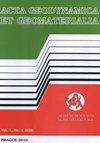伊朗西部Lorestan省Noor abad蛇绿岩的岩石学和地球化学:洋内俯冲的证据
IF 0.8
4区 地球科学
Q4 GEOCHEMISTRY & GEOPHYSICS
引用次数: 0
摘要
Noorabad蛇绿岩是伊朗西部洛雷斯坦省西北部克尔曼沙赫蛇绿岩的一部分。Kermanshah蛇绿岩杂岩呈NW-SE走向,位于Zagros高带内Zagros主逆冲断层的SSW中。努拉巴德蛇绿岩的岩石包括在努拉巴德南部露头的辉绿岩岩脉、玄武岩熔岩和安山岩。这些岩石经过强烈的蚀变和断裂,导致热液蚀变,次生矿物取代了辉石、斜长石和不透明矿物等原生矿物。根据地球化学研究,该地区的岩石具有拉斑玄武岩和钙碱性特征。地球化学判别图中绘制的岩石样品也出现在岛弧玄武岩(IAB)场中。这些岩石显示出HREE和HFSE的贫化,也富含LILE和LREE。这些模式表明这些岩石形成于洋内俯冲带。这些地球化学特征以及与地中海东部其他蛇绿岩的比较,揭示了努拉巴德蛇绿岩中镁铁质岩石形成的俯冲带环境。文章信息本文章由计算机程序翻译,如有差异,请以英文原文为准。
Petrology and Geochemistry of Noor abad ophiolite (Lorestan province, west Iran): an evidence of intra-oceanic subduction
The Noorabad ophiolite is part of Kermanshah ophiolites in NW of Lorestan province, west Iran. The Kermanshah ophiolite complex with NW-SE trending is located in the SSW of the main Zagros thrust fault within the high Zagros zone. Rocks of the Noorabad ophiolite include diabases dikes, basalts lava and andesite that outcropped in the south of the Noorabad. These rocks are intensly altered and fractured that led to hydrothermal alteration and replacement of primary minerals such as pyroxene, plagioclase and opaque minerals by secondary minerals. Based on geochemical studies, the rocks of this area have tholeiitic and calc-alkaline signature. Also the plotted rock samples in geochemical discrimination diagrams, occur in island arc basalt (IAB) field. These rocks show depletion in HREE and HFSE and also are enriched in LILE and LREE. These patterns suggest that these rocks formed in intra-oceanic subduction zone. These geochemical characteristics along with comparison with other ophiolitic rocks in east Mediterranean reveal a subduction zone environment for genesis of the intermediate and mafic rocks of the Noorabad ophiolite. ARTICLE INFO
求助全文
通过发布文献求助,成功后即可免费获取论文全文。
去求助
来源期刊

Acta Geodynamica et Geomaterialia
地学-地球化学与地球物理
CiteScore
2.30
自引率
0.00%
发文量
12
期刊介绍:
Acta geodynamica et geomaterialia (AGG) has been published by the Institute of Rock Structures and Mechanics, Czech Academy of Sciences since 2004, formerly known as Acta Montana published from the beginning of sixties till 2003. Approximately 40 articles per year in four issues are published, covering observations related to central Europe and new theoretical developments and interpretations in these disciplines. It is possible to publish occasionally research articles from other regions of the world, only if they present substantial advance in methodological or theoretical development with worldwide impact. The Board of Editors is international in representation.
 求助内容:
求助内容: 应助结果提醒方式:
应助结果提醒方式:


